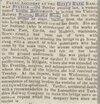I've had some bitter arguments about this bridge and it surprises me how passionate some people can become over it. So, for what it is worth, this is my take on the subject.
Firstly, in the black and white photograph further up the thread, the location of the lower bridge, at the end of Mill Gate, is easy to locate at the modern street level. The original Victoria station buildings are still in existence and in 1850 there is a straight path leading from the entrance of that building along what is now the station front. This passed over the lower bridge and would probably have been very steep. I have recently read a reference to people gaining access to Victoria via some steps and this was possibly where they were located. It is easy to stand on the spot where the station approach runs over the Irk, which means that when you take one step onto the pedestrian crossing, you are right on top of the bridge.
The bridge in the background of the picture seems unlikely to have been for cattle, if only because it isn't wide enough to be useful as one. As confirmation, we have this newspaper article from the Manchester Courier and Lancashire General Advertiser of May 11th, 1850. The bridge is said to connect with Long Millgate, which fits in with any sensible comparison between the photograph and contemporary maps, and it was obviously used for pedestrians. Not only that but as originally constructed, it seems unlikely that it would have withstood the passage of cattle, having only a low handrail over which a person could fall. And that proves that the built up sides of the bridge in the photograph are later additions, post-1850.
I have swapped messages on Facebook with someone who seems to have studied the area around Victoria station extensively and he concluded that the bridge was provided soon after the opening of the station because access along Mill Gate was wholely inadequate. As the river was culverted, and the steep banks were built up, the bridge was retained as a temporary point of access and I believe he said that the point where the bridge ran over the river can be seen in the shape of a bricked-up archway in the wall of the culvert. Once it could be dispensed with, it was, but a section of the bridge was cut out and used to form the present bridge over the river. So the bridge is mainly mid 19th century and has almost certainly been moved from its original location.
And it was never a cattle bridge.


 :
: some more info on this topic here.
some more info on this topic here.